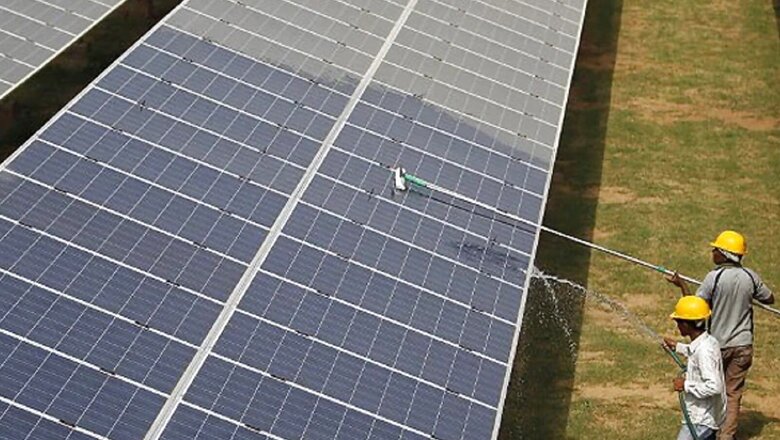
views
India has preferred to let its actions speak than make empty pronouncements on environment at multilateral forums. In the ongoing Conference of the Parties (COP) 26 in Glasgow, Prime Minister Narendra Modi yet again led from the front, pledging a net-zero commitment for India by 2070. This was not just rhetoric; India also presented a “Panchamrit” plan in support of the specific initiatives to be taken to meet climate goals.
One key component of India’s climate ambition is using renewable energy. By 2030, India expects to have 500 gigawatts (GW) of installed renewable energy capacity. The foundation of this ambition was laid by PM Modi at COP21 in Paris five years ago. This was not just a domestic ambition—India guided the world by announcing the formation of the International Solar Alliance (ISA), with France being the co-sponsor.
The ISA was the first multilateral treaty-based organization to be headquartered in India. The foundational premise of ISA is that countries with geographic areas lying between the two tropics have access to ample sunlight. These countries can get together to rapidly scale and promote the use of solar power.
As the United States became the 101st country to sign up for the ISA on the sidelines of COP26, India’s vision is bearing fruit. The world recognizes that the use and adoption of solar power is a key element of the global action on climate. Solar energy is of course intermittent, so massive investments are needed in not just the generation capacity but also in battery storage technologies. A forum like the ISA is best placed to mobilize these global financial investments.
India has stressed on the need for developed countries to arrange for green climate finance. The countries which have used up carbon space to industrialize over the last two centuries cannot ask the developing world to pay for their past actions, now that the issue of carbon emissions has taken global centre-stage. Access to cheap, low-interest, long-tenure capital as well as green technologies and their ready transfer is critical. This criticality applies not just to India’s net-zero pledge but for global efforts to keep the planet’s surface temperature from not increasing in excess of 1.5 degrees by the end of the century.
India’s Renewable Record
India has already worked on world-leading domestic actions on the solar front. In 2014, India’s installed solar capacity was 2 GW. It is now almost 50 GW with several large projects underway. Seventy per cent of all power generation capacity added since 2017 has been renewable in nature. In total, 39 per cent of all Indian power generation capacity is now renewable.
Solar power also gets a priority in our industrialization programmes. These programmes also have an in-built element of responsible, climate-friendly decisions. India aspires to attract global firms as well as Indian firms to build goods that are going to have a positive impact on climate.The High-Efficiency Solar PV Modules Production-Linked Incentive (PLI) under the Ministry of New and Renewable Energy is incentivizing production of low-cost, high-efficiency solar panels. India is pushing industry-ready research and development. The Advance Chemistry Cell (ACC) PLI under the Department of Heavy Industry is going to build rapid, high-quality battery storage technologies in the country.
The PM-KUSUM (Pradhan Mantri Kisan Urja Suraksha evam Utthaan Mahabhiyan) Scheme aims to add solar and other renewable capacity of 26 GW with total central financial support in excess of Rs 34,000 crore. This scheme aims to create 10 GW decentralized ground-mounted, grid-connected renewable power plants, with individual plant size up to 2 MW. The scheme also promotes installation of 17.50 lakh standalone solar-powered agriculture pumps with individual pump capacity up to 7.5 HP. Finally, the scheme aims for solarization of 10 lakh grid-connected agriculture pumps.
The government is creating plug-and-play capability as well attracting solar power installations in mega parks. India aspires to have 25 mega solar parks, each with installed capacity of 20 GW. There are programmes to incentivize private households and commercial establishments to mount rooftop solar. The state government-owned distribution companies are also being incentivized to integrate more solar power in their network.
Working Towards One World, One Sun
In support of these wide-ranging initiatives, the government plans to tackle the issue of climate action on a holistic basis, not link it to narrow considerations like global trade or sector-specific plans like some other countries are proposing. If high-grade steel with higher carbon content is required today to mount solar panels which will be productive for say a couple of decades, why make the production and trade of such steel restrictive? India’s approach to climate has been not to optimize locally but to rather take a big picture view.
The global investments towards solar power and renewable energy in general need to be strategic and focused on the larger end goal of preventing global warming. Each country is best placed to understand how it can address local issues and concerns. Rather than making environment a non-tariff barrier as some of the richer countries and global blocs are currently doing, there should be a recognition that we live in a world of common but differentiated responsibilities. Specifically on renewable energy, the intended determined national contributions should not be undermined by restrictive global trade practices.
The developed world has its strength in global financing. Their COP21 pledge of providing $100 billion in climate finance to developing countries remains unfulfilled. Unfortunately, their words of advice for others refuse to acknowledge their abject failure on the commitment they made. The ISA is a great vehicle for the developed world to demonstrate that they can indeed keep their word and complement India’s global vision of making the most of One World, One Sun.
Nimish Joshi is Director, Smahi Foundation of Policy and Research. He writes on public policy and governance. The views expressed in this article are those of the author and do not represent the stand of this publication.
Read all the Latest Opinions here


















Comments
0 comment